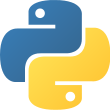 Language
Language
- Python 3
 Reading time
Reading time
- Approximately 55 days
 What you will learn
What you will learn
- Numerical Programming and Data Mining
- Machine Learning and AI
 Author
Author
- Jake VanderPlas
 Published
Published
- 2 years, 5 months ago
 Packages you will be introduced to
Packages you will be introduced to
- matplotlib
- numpy
- pandas
- scikit-learn
- ipython
The author Jake VanderPlas has the following credentials.
- Prominent person behind the ubiquitous Python package scikit-learn
- Prominent person behind the Python package sciPy
- Prominent person behind the Python package astroPy
- Prominent person behind the Python package altair
- Works/Worked at Google
